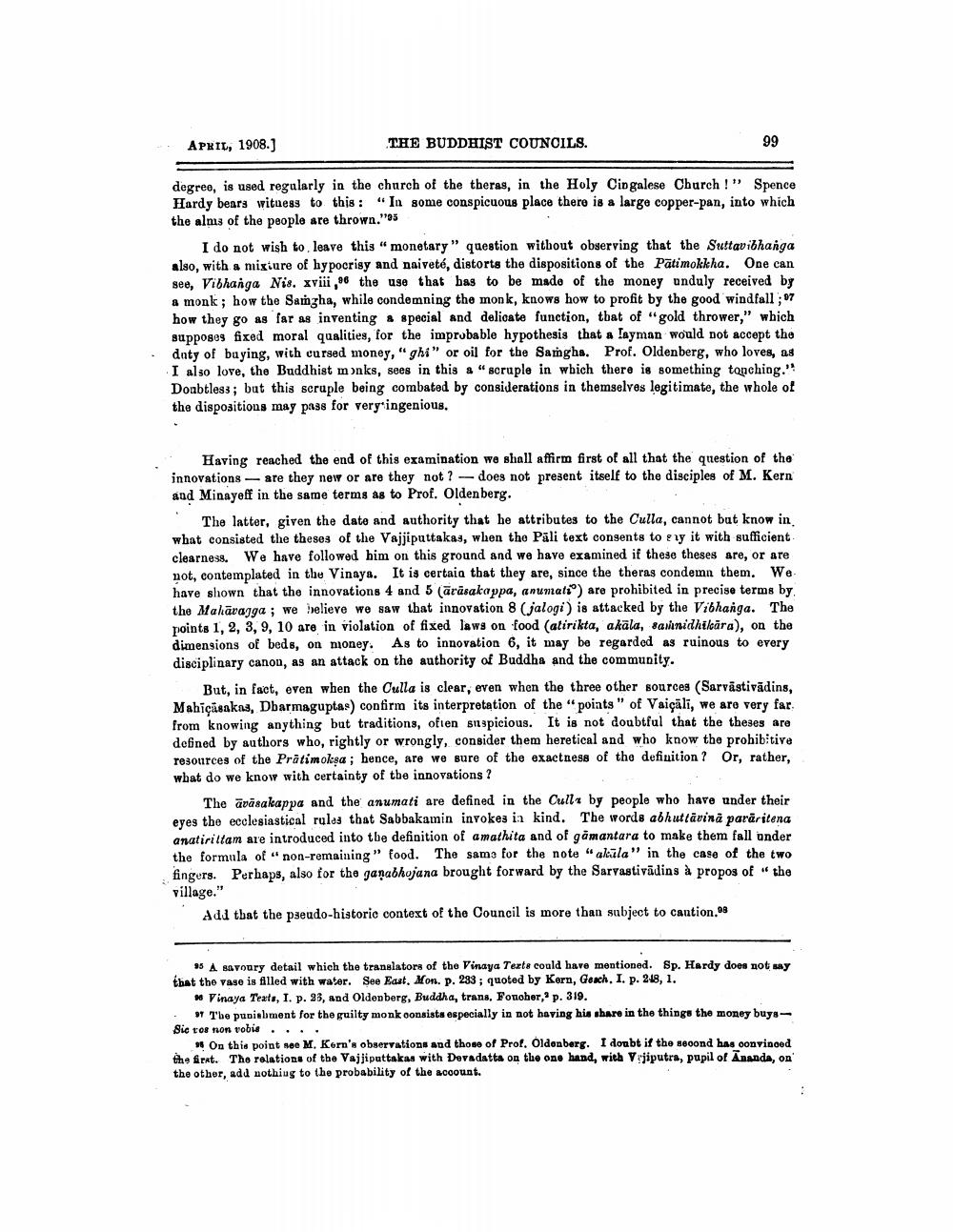________________
APRIL, 1908.)
THE BUDDHIST COUNCILS.
99
degree, is used regularly in the church of the theras, in the Holy Cingalese Church !" Spence Hardy bears witness to this : " In some conspicuous place there is a large copper-pan, into which the alms of the people are thrown."95
I do not wish to leave this monetary" question without observing that the Sultavibhanga also, with a mixture of hypocrisy and naiveté, distorts the dispositions of the Patimokkha. One can see, Vibhanga Nis. xviii, 46 the use that has to be made of the money unduly received by a monk; how the Samgha, while condemning the monk, knows how to profit by the good windfall; 07 how they go as far as inventing a special and delicate function, that of "gold thrower," which supposes fixed moral qualities, for the improbable hypothesis that a layman would not accept the daty of buying, with cursed money, "ghi" or oil for the Samgha. Prof. Oldenberg, who loves, as I also love, the Buddhist mɔnks, sees in this & "scruple in which there is something tonching." Doubtless; but this scruple being combated by considerations in themselves legitimate, the whole of the dispositions may pass for very ingenious.
Having reached the end of this examination we shall affirm first of all that the question of the innovations are they new or are they not? - does not present itself to the disciples of M. Kern and Minayoff in the same terms as to Prof. Oldenberg.
The latter, given the date and authority that he attributes to the Culla, cannot but know in what consisted the theses of the Vajjiputtakas, when the Pāli text consents to eny it with sufficient Clearness. We have followed him on this ground and we have examined if these theses are, or are not, contemplated in the Vinaya. It is certain that they are, since the theras condemn them. We have shown that the innovations 4 and 5 (ārāsakappa, anumati") are prohibited in precise terms by the Mahāvagga ; we believe we saw that innovation 8 (jalogi) is attacked by the Vibhanga. The points 1, 2, 3, 9, 10 are in violation of fixed laws on food (atirikta, akala, salinidhilcāra), on the dimensions of beds, on money. As to innovation 6, it may be regarded as ruinous to every disciplinary canon, as an attack on the authority of Buddha and the community.
But, in fact, even when the Culla is clear, even when the three other sources (Sarvästivādins, Mahicasakna, Dbarmaguptas) confirm its interpretation of the "points" of Vaicali, we are very far. from knowing anything but traditions, often suspicious. It is not doubtful that the theses are defined by authors who, rightly or wrongly, consider them heretical and who know the probibitive resources of the Prātimokşa; hence, are we sure of the exactness of the definition? Or, rather, what do we know with certainty of the innovations ?
The āvāsakappa and the anumati are defined in the Cullt by people who have under their eyes the ecclesiastical rules that Sabbakamin invokes ia kind. The words abhuttävinä paräritena anatirittam are introduced into tbe definition of amathita and of gamantara to make them fall under the formula of non-remaining” food. The same for the note "akūla” in the case of the two fingers. Perhaps, also for the ganabhojana brought forward by the Sarvastivādins à propos of the village."
Add that the pseudo-historic context of the Council is more than subject to caution.
* A savoury detail which the translators of the Vinaya Texts could have mentioned. Sp. Hardy does not say that the vase is filled with water. See East. Mon. p. 233 ; quoted by Kern, Goach. I. p. 218, 1.
* Vinaya Texts, I. p. 33, and Oldenberg, Buddha, trans, Fonoher,' p. 319. • The pupielment for the guilty monk consists especially in not having his share in the things the money buys Sic tos non vobis ....
On this point soe M. Korn's observations and those of Prof. Oldenberg. I doubt if the second has continoed the firat. The relations of the Vajjiputtakas with Devadatta on the one hand, with Vijiputrs, pupil of Ananda, on the other, add nothing to the probability of the account.




